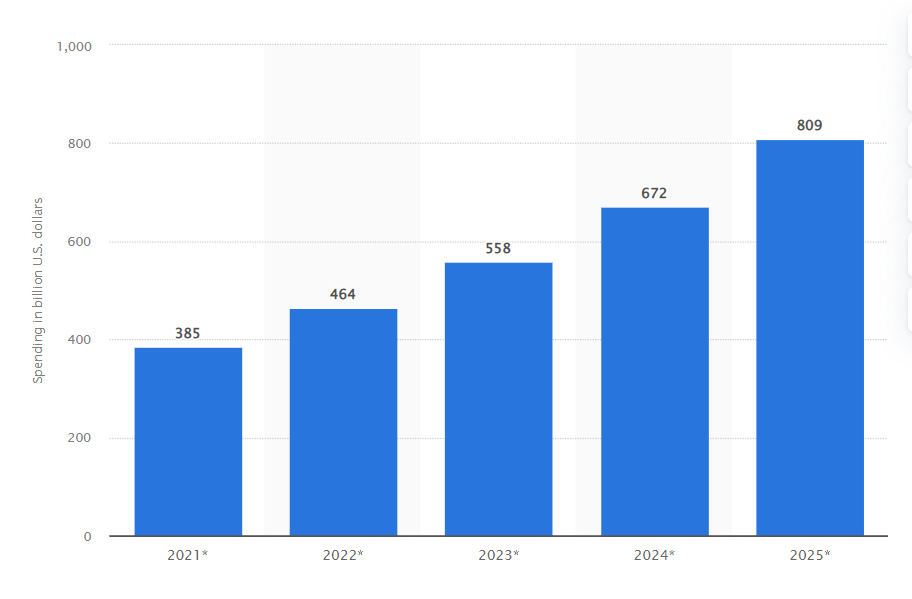
SaaS, PaaS, and IaaS are related to cloud computing, which is gaining momentum these days. To be more precise, they denote three primary models of cloud services.
The main difference between these terms lies in the way the cloud is used in your organization and the out-of-the-box products offered by the vendor.
In this article, we will consider each of these models. We will compare Iaas vs Paas vs Saas and show in what cases you can benefit most from using each of these models.
What is cloud computing?
In simple words, cloud computing provides an opportunity to rent information technology instead of buying it. Rather than investing many resources in hardware, and software, companies prefer to access computing resources via the web or the cloud and pay for their use.
Cloud solutions include but are not limited to databases, servers, storage, software, networks, and business intelligence.
Thanks to cloud computing, enterprises can quickly develop, innovate, and maintain business IT solutions.
Why do companies choose cloud solutions? Here are some reasons:
- Availability via the Internet, regardless of time and location;
- No need to spend money on system administrators, hardware, and software updates – all this is on the provider’s side;
- Rapid scalability through the use of virtual resources;
- Different levels of user access and permissions;
- Comprehensive service and technical support.
By the way, below, you can see the forecast for combined spending on shared cloud services globally from 2021 to 2025 (in billion U.S. dollars).

Source: Statista.com
According to Gartner, corporate IT spending associated with the transition to the cloud will grow to nearly $1.8 trillion by 2025.
In general, choosing a PaaS, SaaS, or IaaS cloud model for an e-commerce system is a decision with many criteria. Each model has its pros and cons depending on your business practices and the properties of the software itself. That’s what we’ll talk about here.
SaaS (software-as-a-service)
This cloud model is the most common. Services and programs are developed and maintained by the provider. The provider hosts them in the cloud and offers these programs or services to the end-user through an application on their PC or a browser.
The client only pays the subscription charge or uses the service for free. At the same time, the provider is responsible for technical support and updating of programs.
In short, SaaS means that a provider makes the application available to users over the Internet on a subscription basis.
SaaS services can provide a place to store files, an office suite of documents for work, or help communicate with others.
The main benefits of this model are the following:
- SaaS reduces initial costs.
- This model provides access to apps worldwide.
- The SaaS model can be used on any device comprising smartphones.
- This model has automatic software updates.
- SaaS is available “out of the box” – you just need to register.
At the same time, you should take into account such drawbacks of SaaS solutions as performance issues and the lack of integration support.
Now let’s discuss the major cases when you should give SaaS cloud model a try:
- You are a startup with limited resources. You want to launch an e-commerce project quickly and do not have time or money to deal with server issues.
- Your cloud application will be used only occasionally.
- You need both web and mobile access for your app.
- A short-term project your team is working on requires fast collaboration.
The most famous examples of SaaS:
- Dropbox Workspace,
- Salesforce,
- Google Workspace,
- Service Now,
- Cisco WebEx,
- SimpleOne.
PaaS (platform-as-a-service)
In this case, the cloud provider permits access to operating systems, testing and development tools, and database management systems. The provider controls servers, data storage systems, and computing power. Also, it offers the user a choice of certain platforms and means of managing them.
With the PaaS model, you get a cloud environment that allows the creation of custom apps.
This option can bring companies multiple benefits, including quick launch, reduced development time, and easy maintenance.
What are the advantages of PaaS solutions:
- The PaaS service provider undertakes software updates, patches, and maintenance.
- The client does not need to invest in equipment and software – the provider offers everything necessary.
- Platform deployment flexibility.
However, businesses should be aware that PaaS solutions have downsides as well. These are a lack of customization for legacy systems, runtime issues, and possible changes from the PaaS vendor.
PaaS solutions are the right choice in the following cases:
- Your company specializes in custom software development or building mobile apps.
- You need to speed up the collaborative work on the same project.
The most famous PaaS examples are the following:
- Google App Engine,
- AWS Elastic Beanstalk,
- Heroku,
- Windows Azure,
- Apache Stratos,
- Openshift.
IaaS (infrastructure-as-a-service)
IaaS differs from other cloud service models by providing the rent of only physical devices and a network connection to the Internet. Software, including OS, under the IaaS service model, is installed by your company independently. Notably, the data center is not responsible for the operation of these applications.
What are the advantages of IaaS:
- Budget savings due to the transfer of infrastructure expenses to the provider.
- Data is placed in the data center of the provider, where it is protected by security systems at the physical and software level.
- Easily scale as your company grows.
The key advantages of the IaaS cloud computing model are on-demand scalability, operational flexibility, and great reliability.
The main downsides that are worth mentioning are issues with legacy systems and the necessity of internal training. In addition, your data is stored by a third party. Even though the data is encrypted, this item always causes concern among customers.
You should consider switching to IaaS products if:
- You are using big data.
- Your company is growing rapidly.
- You want to add other features in your app in the future.
The most known examples of IaaS:
- Amazon Web Services (AWS),
- DigitalOcean,
- Cisco Metapod,
- Google Compute Engine (GCE),
- Linode,
- Microsoft Azure.
Each cloud model offers specific features and capabilities. When a business has a set of specific goals and an understanding of the benefits of different types of cloud services, it is easier to choose the right one.
How to select the right cloud model for your business?
When choosing a cloud service model, you need to focus primarily on the tasks you need to solve. Below you can see a table that helps you to compare pros and cons of each of the cloud models we considered.
| SaaS | PaaS | IaaS |
| Why? | ||
|
|
|
| Gaps | ||
|
|
|
| For what? | ||
| The best and the most cost-effective choice for small-scale businesses | For projects with various developers and merchants, when you need to speed up the collaborative work | This is choice for you if you need a control over the hardware infrastructure |
Conclusion
Let’s emphasize the advantages of each of the models:
- IaaS solutions give you near-total control over the out-of-the-box infrastructure, allowing an organization to create a technology stack that is fully tailored to business needs.
- Businesses with some resources and an IT department can choose PaaS services: a ready-made platform will help companies develop customized solutions that are easier to integrate with existing workflows.
- SaaS services allow businesses to save money by eliminating the need for customers to develop and maintain the software themselves.
On the surface, SaaS, PaaS, and IaaS models seem similar. Nevertheless, they provide different levels of services. However, in any case, cloud solutions help save time, the effort of employees, and money. The cloud is the future of technology for business development.
